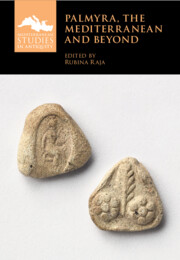Book contents
- Palmyra, the Mediterranean and Beyond
- Mediterranean Studies in Antiquity
- Palmyra, the Mediterranean and Beyond
- Copyright page
- Contents
- Figures
- Maps and Tables
- Contributors
- 1 Palmyra in the Mediterranean World
- 2 The Western Networks of Palmyra
- 3 You Can’t Get There from Here
- 4 Palmyrene Iconographic Traditions and Their Mediterranean Connections
- 5 Palmyra and Emesa or ‘Palmyre sans Émèse’
- 6 Organizing Networks to Supply Mediterranean Markets
- 7 Language, Law and Religion
- 8 Channels of Communication and Connections of Style
- 9 Identity and Mobility of Palmyrene Jews
- 10 Palmyrene Military Expatriation and Its Religious Transfer at Roman Dura-Europos, Dacia and Numidia
- Index
- References
8 - Channels of Communication and Connections of Style
Palmyrene Portraiture in Its Wider Context
Published online by Cambridge University Press: 21 October 2025
- Palmyra, the Mediterranean and Beyond
- Mediterranean Studies in Antiquity
- Palmyra, the Mediterranean and Beyond
- Copyright page
- Contents
- Figures
- Maps and Tables
- Contributors
- 1 Palmyra in the Mediterranean World
- 2 The Western Networks of Palmyra
- 3 You Can’t Get There from Here
- 4 Palmyrene Iconographic Traditions and Their Mediterranean Connections
- 5 Palmyra and Emesa or ‘Palmyre sans Émèse’
- 6 Organizing Networks to Supply Mediterranean Markets
- 7 Language, Law and Religion
- 8 Channels of Communication and Connections of Style
- 9 Identity and Mobility of Palmyrene Jews
- 10 Palmyrene Military Expatriation and Its Religious Transfer at Roman Dura-Europos, Dacia and Numidia
- Index
- References
Summary
This chapter juxtaposes Palmyrene funerary portraiture with the portraiture of Egypt and Pannonia in the first three centuries AD to discern stylistic connections between the provincial centres as well as to the portraiture produced in Rome. Due to its inherently subjective (and hence, flawed) nature, the notion of style as an interpretative framework has fallen by the wayside in archaeology and art history. This chapter will return to the concept of style and evaluate its helpfulness in determining the significance of Palmyrene funerary portraiture in the context of Roman provincial portraiture. Is it appropriate to describe Palmyrene portraiture as ‘Roman’ in style, or perhaps, ‘eastern Mediterranean’, and at what point does it become ‘Palmyrene’? A better understanding of the place of this portraiture in terms of style, not only in antiquity but also in contemporary analyses of funerary portraiture in the Roman world, enhances our ability to interpret its significance at the local level.
Information
- Type
- Chapter
- Information
- Palmyra, the Mediterranean and Beyond , pp. 167 - 186Publisher: Cambridge University PressPrint publication year: 2025
References
Accessibility standard: WCAG 2.1 AA
Why this information is here
This section outlines the accessibility features of this content - including support for screen readers, full keyboard navigation and high-contrast display options. This may not be relevant for you.Accessibility Information
Content Navigation
Allows you to navigate directly to chapters, sections, or non‐text items through a linked table of contents, reducing the need for extensive scrolling.
Provides an interactive index, letting you go straight to where a term or subject appears in the text without manual searching.
Reading Order & Textual Equivalents
You will encounter all content (including footnotes, captions, etc.) in a clear, sequential flow, making it easier to follow with assistive tools like screen readers.
You get concise descriptions (for images, charts, or media clips), ensuring you do not miss crucial information when visual or audio elements are not accessible.
You get more than just short alt text: you have comprehensive text equivalents, transcripts, captions, or audio descriptions for substantial non‐text content, which is especially helpful for complex visuals or multimedia.
Visual Accessibility
You will still understand key ideas or prompts without relying solely on colour, which is especially helpful if you have colour vision deficiencies.
Structural and Technical Features
You gain clarity from ARIA (Accessible Rich Internet Applications) roles and attributes, as they help assistive technologies interpret how each part of the content functions.
